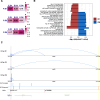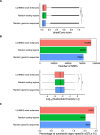Transcriptional enhancers in human neuronal differentiation provide clues to neuronal disorders
- PMID: 39948187
- PMCID: PMC11893885
- DOI: 10.1038/s44319-025-00372-1
Transcriptional enhancers in human neuronal differentiation provide clues to neuronal disorders
Abstract
Genome-wide association studies (GWASs) have identified thousands of variants associated with complex phenotypes, including neuropsychiatric disorders. To better understand their pathogenesis, it is necessary to identify the functional roles of these variants, which are largely located in non-coding DNA regions. Here, we employ a human mesencephalic neuronal cell differentiation model, LUHMES, with sensitive and high-resolution methods to discover enhancers (NET-CAGE), perform DNA conformation analysis (Capture Hi-C) to link enhancers to their target genes, and finally validate selected interactions. We expand the number of known enhancers active in differentiating human LUHMES neurons to 47,350, and find overlap with GWAS variants for Parkinson's disease and schizophrenia. Our findings reveal a fine-tuned regulation of human neuronal differentiation, even between adjacent developmental stages; provide a valuable resource for further studies on neuronal development, regulation, and disorders; and emphasize the importance of exploring the vast regulatory potential of non-coding DNA and enhancers.
Keywords: CAGE; Enhancer; Hi-C; LUHMES; Neuron.
© 2025. The Author(s).
Conflict of interest statement
Disclosure and competing interests statement. YM is an inventor on a patent related to the NET-CAGE technology. Other authors declare no competing interests.
Figures












References
MeSH terms
Grants and funding
LinkOut - more resources
Full Text Sources

